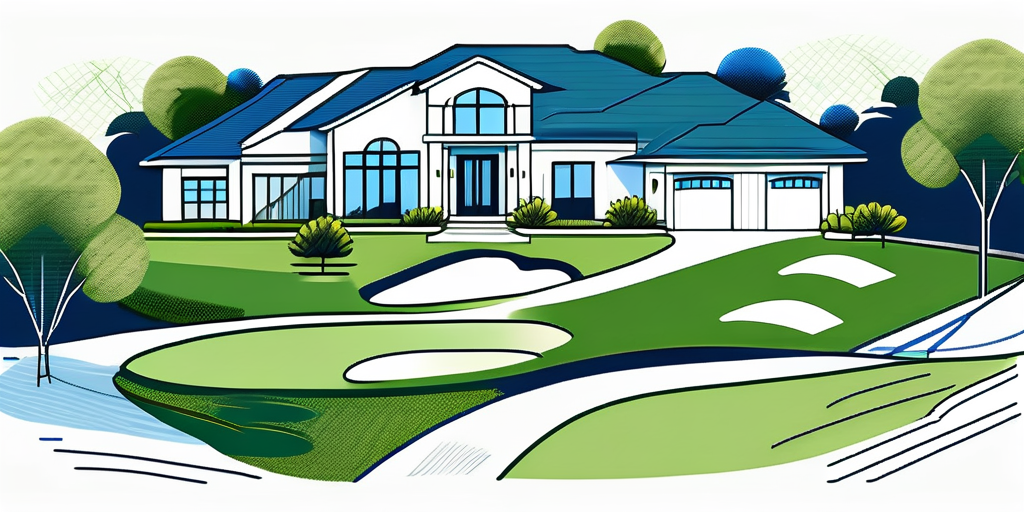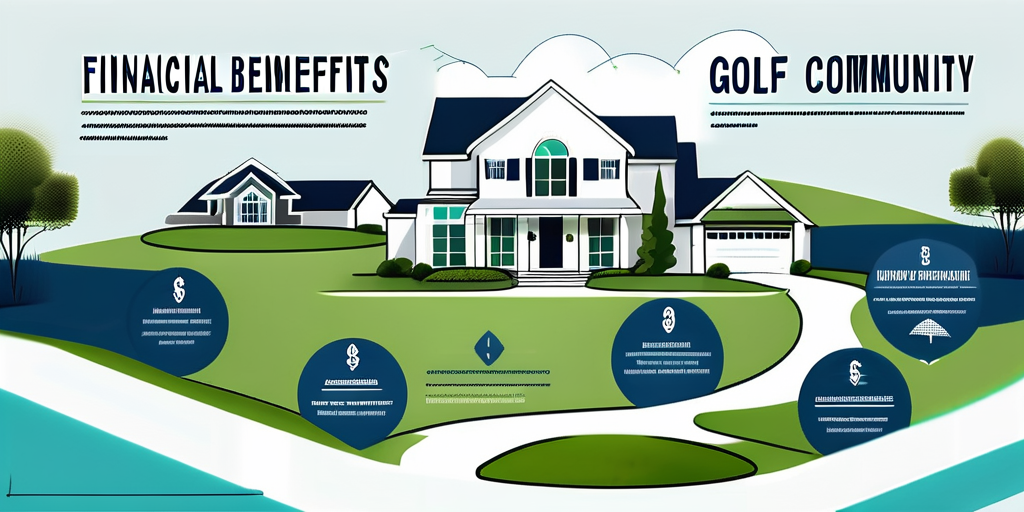
Golf community real estate presents a unique investment opportunity that combines both lifestyle and financial benefits. As more people look for homes that offer a blend of leisure and comfort, golf communities have gained popularity among retirees, families, and second-home buyers alike. In this article, we’ll explore the various dimensions of investing in golf community real estate, including its distinctive features, financial advantages, lifestyle benefits, key factors to consider, and future prospects.
Golf community real estate refers to residential properties that are integrated within or adjacent to golf courses. These developments often come with a variety of amenities designed for golf enthusiasts, but they can also appeal to those who appreciate luxurious living in serene environments. Typically, these properties include single-family homes, condos, and townhouses, all nestled amidst beautifully landscaped greens.

At its core, golf community real estate offers a unique living experience. But what exactly defines it? Essentially, these are planned communities where the central attraction is the golf course. Residents may have access to clubhouses, swimming pools, fitness centers, and other recreational facilities that enhance their quality of life. The properties are often well-maintained and include features that cater to an active lifestyle.
This type of real estate not only stands out due to its golfing amenities but also boasts a strong sense of community. Residents are usually like-minded individuals who enjoy the sport and outdoor activities, forging friendships and bonds that can last a lifetime. Many communities organize regular events, such as golf tournaments, social gatherings, and fitness classes, which further foster a sense of belonging and camaraderie among residents.
One of the standout features of golf community properties is their design and architecture. These homes are often built with spacious layouts, high-quality finishes, and panoramic views of the golf course. Many properties also come with their own private outdoor spaces, ideal for entertaining guests or simply relaxing after a round of golf.
Another unique aspect is the sense of security and privacy offered by gated golf communities. Residents often enjoy a safer environment, as access is controlled, and neighborhood watch initiatives are common. This peace of mind enhances the overall living experience, making it appealing for families and retirees alike. Additionally, many golf communities are strategically located near urban centers, providing residents with convenient access to shopping, dining, and cultural attractions while still maintaining a tranquil atmosphere. This blend of accessibility and exclusivity makes golf community real estate an attractive option for those seeking a balanced lifestyle.
Investing in golf community real estate is not only about lifestyle—there are also compelling financial reasons to consider it. The combination of location, amenities, and the overall appeal of these communities can lead to significant returns on investment.

The demand for properties in golf communities has shown an upward trend, making it a potentially lucrative investment. These properties often appreciate faster than those in standard residential neighborhoods, particularly if they are located near desirable golf courses and recreational facilities. Investors may find that their property value increases significantly over time, creating a substantial return on their initial investment.
Additionally, the rental market for these properties can be quite robust, especially during peak seasons. Investors can capitalize on short-term rentals to vacationers and golf enthusiasts, adding another layer of income potential. Many golf communities also offer unique amenities such as clubhouses, fitness centers, and organized events, which can further entice renters and buyers alike. This added appeal not only enhances the rental income but also increases the overall marketability of the property.
Golf community real estate also provides a certain level of stability. The demographic of residents often includes retirees and affluent individuals, which means there is a consistent demand for these types of properties. The stability of the community and its desirability tends to insulate investors from drastic market fluctuations.
Furthermore, golf communities often have protective covenants and property owners' associations that maintain the neighborhood's standards, contributing to the long-term value of the properties. This can be particularly attractive for those looking for an investment that will stand the test of time. In addition, the sense of community fostered within these neighborhoods often leads to lower turnover rates, as residents are more likely to stay long-term, ensuring a steady demand for properties. This stability is further enhanced by the fact that many golf communities are situated in areas with strong local economies and access to essential services, making them even more appealing to potential buyers and renters.
Beyond the financial allure, living in a golf community offers a full lifestyle upgrade. Residents often enjoy access to an array of amenities that extend well beyond the golf course.

One of the most significant benefits of golf community living is the access to top-notch amenities. Most golf communities feature clubhouses comprising restaurants, lounges, and event spaces for gatherings and celebrations.
In addition to golfing facilities, many communities offer fitness centers, swimming pools, tennis courts, and walking trails. All these amenities create a lifestyle centered around health, wellness, and socializing, which is hard to find in traditional neighborhoods. Moreover, the presence of well-maintained landscapes and gardens enhances the aesthetic appeal of the community, making it a picturesque environment for residents to enjoy leisurely strolls or outdoor picnics with family and friends.
Golf communities are inherently social. Living amongst fellow golf enthusiasts creates opportunities for camaraderie and shared experiences. Many communities organize events, tournaments, and social gatherings that encourage residents to meet, mingle, and forge friendships.
For families, this social atmosphere extends to their children and offers a sense of belonging in an otherwise vast and detached world. The community may host family-friendly events, further enhancing the quality of life and adding a wholesome community spirit. Additionally, many golf communities provide clubs and interest groups that cater to various hobbies and activities, from book clubs to cooking classes, ensuring that there is always something engaging happening, fostering deeper connections among residents.
Furthermore, the lifestyle in a golf community often promotes a sense of security and peace of mind. With gated entrances and community patrols, residents can feel more at ease, allowing them to focus on enjoying their surroundings and participating in community activities. This added layer of safety not only enhances the living experience but also encourages families to let their children explore the neighborhood freely, building a close-knit environment where everyone looks out for one another.
Before making the leap into investing in golf community real estate, there are several important factors to consider that can influence both the investment and lifestyle experience.
Location is vital when choosing a property in a golf community. Proximity to major cities, airports, and other recreational areas can significantly impact the property’s value and attractiveness.
Additionally, it's important to research market trends in the area. Understanding the local real estate market, including appreciation rates and rental demand, can help you make informed investment decisions. For instance, areas with a growing population and increasing interest in golf can lead to higher property values over time. Furthermore, consider the seasonality of the market; some regions may see a surge in demand during peak tourist seasons, which can affect rental income potential.
While golf community living comes with numerous benefits, it also often involves homeowner association (HOA) fees. These fees typically cover maintenance, landscaping, and the upkeep of communal amenities. Potential investors should factor these costs into their overall budget.
Understanding the structure of maintenance fees and their potential increase over time is crucial for ensuring a profitable investment in the long run. It’s also wise to inquire about the financial health of the HOA; a well-managed association can enhance property values, while a poorly managed one may lead to unexpected costs or decline in community standards. Additionally, consider the amenities offered by the community—such as clubhouses, fitness centers, and pools—as these can significantly enhance the lifestyle experience and attract potential renters or buyers, thereby increasing your investment's appeal.
The future of golf community real estate appears promising, with various trends shaping its landscape. As lifestyle preferences evolve, predictions indicate continued interest in these unique living spaces.
As baby boomers retire and millennials seek new living arrangements, golf communities are likely to appeal to a diverse range of demographics. These communities not only cater to avid golfers but also attract those who prioritize an active lifestyle, premium amenities, and a sense of community.
With the trend of downsizing among older adults, golf communities can provide the perfect solution for retirees looking for a vibrant yet relaxed environment, ensuring the demand remains high. Furthermore, younger families are increasingly drawn to these areas for their family-friendly amenities, such as playgrounds, swimming pools, and organized social events. This blend of generations fosters a unique atmosphere where experiences and traditions can be shared, enriching the community fabric and enhancing the overall living experience.
Another important factor shaping the future of golf community real estate is the increasing focus on sustainability. Developers are becoming more conscious of environmental impact, leading to the incorporation of eco-friendly designs and practices.
As sustainability continues to be a priority for future homebuyers, golf communities that embrace green initiatives are likely to maintain their appeal and value over time. This includes everything from water conservation systems to energy-efficient homes, positioning these communities as not just desirable but responsible choices. Additionally, many golf courses are transitioning to organic maintenance practices, reducing chemical usage and promoting biodiversity. This not only enhances the natural beauty of the surroundings but also attracts environmentally conscious buyers who value a lifestyle that aligns with their ecological principles. The integration of walking trails, bike paths, and community gardens further enhances the appeal, making these neighborhoods not just places to live, but vibrant ecosystems that foster a deep connection to nature.
In conclusion, investing in golf community real estate offers a unique blend of lifestyle benefits and financial advantages. As you consider this investment opportunity, keep in mind the various aspects discussed in this article, from understanding what defines golf community properties to the future prospects fueled by demographic shifts and sustainability. For many, living in a golf community is not just about owning a home—it's about embracing a lifestyle filled with opportunity, connection, and relaxation.